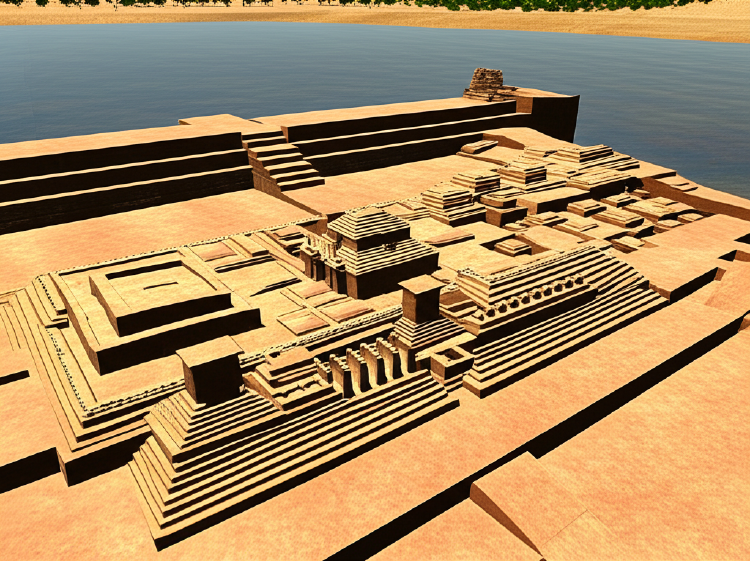Lothal: The Well-Planned City of the Indus Valley Civilization
Lothal is one of the most prominent archaeological sites in India, belonging to the Indus Valley Civilization. It is located near Bhagwanpur village in the Sabarkantha district of Gujarat. The site is famous for its well-planned city layout, including a dockyard, houses with advanced drainage systems, and numerous artifacts that provide insights into the daily life of the ancient inhabitants.
- Muthukrishnan
- 5 min read

Introduction
Lothal, a significant archaeological site located in the state of Gujarat, India, near the village of Bhagwanpur, stands as a testament to the advanced civilization of the Indus Valley Civilization (IVC). This ancient city offers a captivating glimpse into the urban planning, trade, and daily life of the Harappan people. Situated approximately 85 kilometers (53 miles) southwest of Ahmedabad, Lothal provides a tangible link to a bygone era, offering a unique and immersive experience for history enthusiasts and curious travelers alike. It’s strategically located near the Gulf of Khambhat (Cambay), making it a key port and a major trading hub during its time.
History and Cultural Heritage
Lothal’s history stretches back over 4,500 years, placing it within the heart of the Indus Valley Civilization (also known as the Harappan Civilization), which flourished from approximately 2600 to 1900 BCE. Excavations conducted by the Archaeological Survey of India (ASI) unearthed the remarkably well-planned city, revealing a sophisticated understanding of urban design, engineering, and trade. The site demonstrates the standardized brick-making techniques, drainage systems, and a planned grid-like layout characteristic of the IVC. Lothal’s significance lies in its advanced infrastructure including its monumental dockyard, believed to be one of the earliest known examples of a port. The artifacts discovered at Lothal, including pottery, jewelry, seals, and tools, offer insights into the lifestyle, religious beliefs, and trade routes of the Harappan people. The site faced decline with the decline of the IVC.
Natural Beauty
While Lothal is primarily a historical site, the surrounding landscape of Gujarat, specifically the region in which it’s situated, offers a glimpse into the geography of the area during the Indus Valley Civilization’s time. The area is relatively flat, with the Gulf of Khambhat historically playing a significant role in Lothal’s port activities. The area is now primarily agricultural and offers a serene setting to reflect on the ancient city’s significance.
Must-Visit Attractions
- The Lothal Archaeological Site: The centerpiece is, of course, the ruins of the ancient city. Visitors can explore the remains of the dockyard, the acropolis (the upper part of the city, probably for elite residents), the lower town, and the warehouses. The layout reveals the meticulous planning of the Harappan people.
- Lothal Museum: The on-site museum displays a rich collection of artifacts recovered from the excavation, providing a comprehensive understanding of the daily life, trade practices, and craftsmanship of the Lothal people. Displays include pottery, beads, jewelry, tools, seals, and terracotta figurines.
Adventure Activities
Given its primarily historical context, adventure activities are limited within Lothal itself. However, exploring the surrounding areas provides opportunities for activities such as:
- Rural Excursions: Explore the surrounding rural landscape and villages.
Local Markets and Handicrafts
The local markets near Lothal offer glimpses of Gujarati crafts, though they are not specific to Lothal’s Harappan heritage. Visitors may find:
- Handmade Textiles: Gujarat is renowned for its vibrant textile traditions, including bandhani (tie-dye), block printing, and embroidered fabrics.
- Traditional Jewelry: Local artisans create jewelry inspired by the region’s rich cultural heritage.
Food and Cuisine
Gujarati cuisine is known for its vegetarian dishes, with a blend of sweet, savory, and spicy flavors. Travelers should try:
- Thali: A comprehensive platter featuring a variety of dishes such as dal (lentils), roti (Indian bread), rice, vegetables, and sweets.
- Dhokla: A steamed savory cake made from fermented batter.
- Khandvi: Rolled, bite-sized snacks made from gram flour.
Flora and Fauna
While the Lothal site doesn’t have a specific focus on flora and fauna, the surrounding Gujarat region offers opportunities to explore diverse ecosystems.
Best Time to Visit
The ideal time to visit Lothal is during the cooler months, from October to March. The weather is pleasant during this time, making it conducive to exploring the archaeological site and museum. The summer months (April to June) can be very hot and are best avoided.
How to Reach
- By Air: The nearest airport is Sardar Vallabhbhai Patel International Airport in Ahmedabad. From there, you can hire a taxi or take a bus to Lothal (approximately a 2-hour drive).
- By Rail: The nearest railway station is in Ahmedabad. From the station, taxis and buses are available to reach Lothal.
- By Road: Lothal is well-connected by road. You can drive from Ahmedabad or hire a taxi from any major city in Gujarat.
Accommodation Options
Accommodation options are limited near the Lothal site. Travelers can consider:
- Hotels and Guesthouses in nearby towns: Ahmedabad has a wide range of hotels, from budget-friendly to luxurious options.
- Homestays: Consider exploring homestays in the surrounding villages to get closer to the local culture.
Offbeat Experiences
- Visit the surrounding villages: Interact with the local communities and get a glimpse of their lifestyle.
- Learn about Harappan Civilization: Enrich your trip with a visit to other Indus Valley Civilization sites to get a deeper understanding.
Conclusion
Lothal is a compelling destination for anyone interested in history, archaeology, and ancient civilizations. Visiting this site provides an unparalleled opportunity to step back in time and witness the brilliance of the Indus Valley Civilization. The well-preserved ruins, the informative museum, and the surrounding landscapes create an immersive and enriching experience. By exploring Lothal, visitors not only learn about the past but also gain a profound appreciation for the ingenuity and advanced civilization of the Harappan people. It’s a journey through time, a chance to connect with a lost world and discover the roots of urban planning and trade that shaped human civilization.